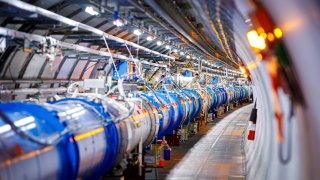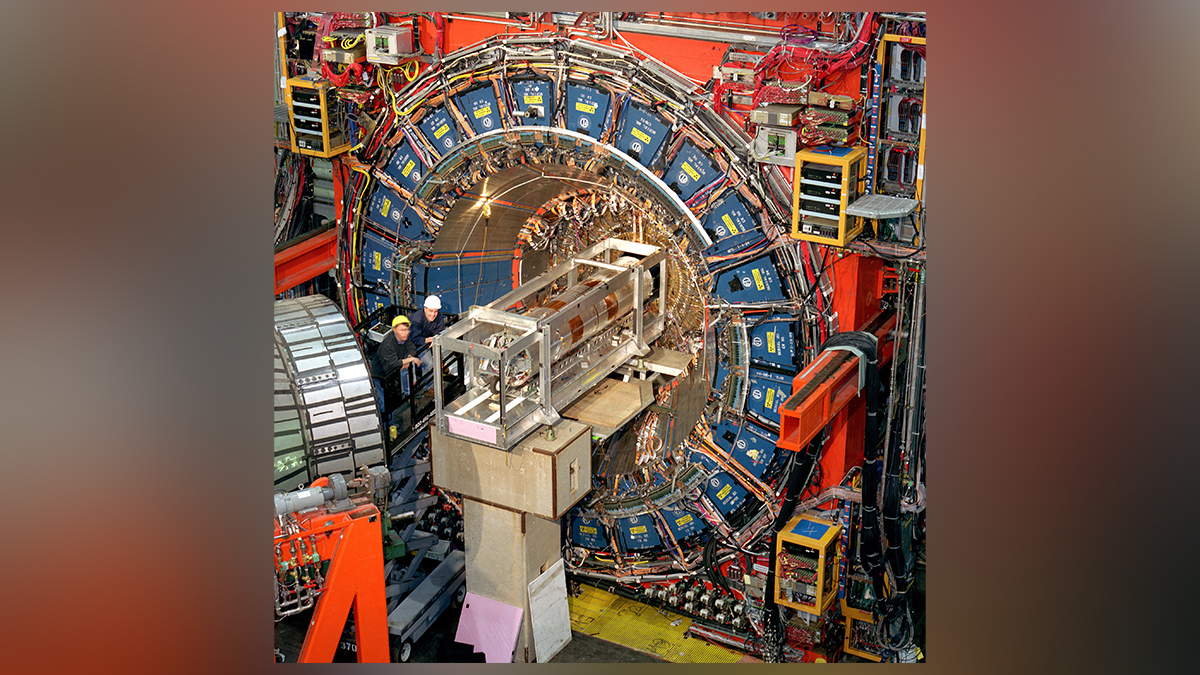
Picture a particle physicist. What do they look like as they do their research?
There's a certain popular image of what a scientist looks like while they make their discoveries, according to Dr. Jonathan Lee Feng, professor of physics and astronomy at UC Irvine.
"I think a lot of laypeople think of scientific progress as something made by some genius sitting at their table, who has some sort of "Eureka" moment," Feng said in a phone interview with NBC4.
But that idea isn't quite accurate.
Get Southern California news, weather forecasts and entertainment stories to your inbox. Sign up for NBC LA newsletters.
"Science now is very social, and relies on interactions," he explained -- and those interactions and collaborations happen at conferences like Snowmass, being held in Seattle from July 17 to July 26 this year.
Particle physics is the study of the tiny particles that form the building blocks of all known matter in the universe. If you're a particle phycisist, you might study quarks, which make up protons and neutrons, or leptons, a kind of particle which includes electrons. Those particles, put together, create atoms, which make up everything else.
Snowmass, also known as the Snowmass Community Planning Exercise, is an academic conference for U.S. particle physicists, and some of the international particle physicists they collaborate with. At the conference, they propose new research topics, areas of study, and potential experiments, with the goal of building out the next stage of U.S. particle physics research.
But that description alone doesn't quite capture the scale of the event.
The conference is sponsored and put together by a subset of the American Physical Society -- "a nonprofit membership organization working to advance the knowledge of physics," according to its website.
It's a professional society of sorts for physicists, with "more than 50,000 members, including physicists in academia, national laboratories, and industry in the United States and throughout the world."
Within the broader APS, the Division of Particles and Fields is a group of scientists focusing just on what most people know as particle physics, the field maybe best known for creating the Large Hadron Collider in Switzerland.
Or, as the DPF puts it, they focus on "the study of fundamental particles and fields, their structure, their interactions and interrelationships, the design and development of high energy accelerators, and the design and development of instrumentation techniques for high energy physics."
Essentially, if you're a researcher within the field of particle physics, you've probably heard of the Snowmass conference.
"It’s basically a chance for the whole community of, in this case particle physicists, to get together and take stock of where we are," Feng said, and use that assessment of the U.S. research that already exists to "make a plan for where to go."
That plan is made on a large timescale.
The first Snowmass conference was held in 1982, in the town of Snowmass, Colorado -- hence the name. The conference takes place again every decade or so, according to Dr. Sekhar Chivukula, professor at UC San Diego, chair-elect of the DPF and one of the organizers of Snowmass.
"After a period of study by subgroups of scientists studying various sub fields, we come together across sub fields to work to create a unified vision for the future," Chivukula said in an email.
It's a very collaborative process, and one that actually begins years in advance of the conference date, according to Dr. Pedro Ochoa-Ricoux, an associate professor at UC Irvine.
"Snowmass is a process," he said in a phone call, and the conference "is the culmination of the process."
The process starts with letters of interest that are solicited from particle physicists around the U.S. -- two-page, "short and sweet" explanations of what researchers are interested in, and why they think it's important, Ochoa-Ricoux said.
Those letters of interest lead to what are known as "white papers," which are reports or guides that present a simplified version of a complex research idea.
Instead of the broader summary in the letters of interest, the white papers contain a specific problem in physics to solve, the details of what the problem is, how the authors think it could be addressed, and pros and cons for why that method of research is better than hypothetical other methods, Ochoa-Ricoux said.
The white papers essentially serve as arguments for a particular experiement or idea that the authors think should get attention at the conference.
Those papers then get shared with the "frontier" group, or group of researchers for one area of particle physics study, to be reviewed, considered, and selected for the next step.
"The whole Snowmass process is divided into 10 frontiers," Ochoa-Ricoux said, because particle physics as a field of physics is so broad that it needs to be divided up.
For example, the energy frontier focuses on understanding heavy particles, new kinds of particle interactions, and the mystery of dark matter -- which particle physicists still don't have a lot of information about, despite the fact that it makes up roughly 85% of matter in universe, according to Feng.
"We don’t have any idea what it is," Feng said. "We’d desperately like to have some clues about this."
And the search for clues means plenty of potential research projects.
Within the frontiers are different topical groups, dividing the research areas even more, but the end result of all the subgroups, papers, discussions and reviews lead to a bigger report.
The endgame for Snowmass is a report, Ochoa-Ricoux said, with a section from each of the 10 frontiers made up of pieces from each of the topical groups.
"It’s a bottom-up process," he said.
It starts with a wider group of physicists and students, and making its way up to people at the top of the field.
"This is really a very American thing, a very sort of democratic thing, an idea that everyone should sort of have a say," Feng said. "There’s a lot of emphasis on making sure that everybody, maybe early career physicists, maybe grad students" are included in the process.
Their work ends with a set of reports "detailing the current state of the field and the most exciting experimental and theoretical opportunities for progress," Chivukula said. And those reports help determine where the finite funding available can best be used to advance the broad field of particle physics.
Snowmass basically sets the menu that U.S. funding agencies, like the Department of Energy and the National Science Foundation, select future projects from, Feng explained.
"We’ve got a bunch of big projects," Feng said.
The bigger ones that take more people, equipment, time and funding are the entrees, smaller projects are desserts and the weirder-but-interesting ideas are appetizers -- but you're not going to be able to eat, or pay for, everything on the menu.
"So then someone basically has to pick from the menu," Feng said. "What are we actually going to order?"
The Snowmass reports go to what's known as P5 -- the Particle Physics Project Prioritization Panel -- which prioritizes the ideas that all the conference attendees, frontier researchers, and white paper authors set forth, and "forms a plan for what can actually be built in the next five, 10, 15 years," Feng said.
That recommendation is sent to the DOE and NSF, who actually implement the suggestions in the form of grants and budget proposals to the U.S. government.
After the whole process is done, particle physicists know what direction the field is taking for the next 10 years or so -- until the next Snowmass conference convenes.
"These reports will be used by the agencies in making the budget proposals to the Congress over the coming decade," Chivukula said. "This joint effort by the particle physics community in coordination with the government agencies has been extremely effective in creating and maintaining a cutting-edge particle physics program in the US."
But beyond the money, the conference helps direct particle physics as a field by bringing scientists together, from areas of study that may not otherwise interact.
"You emerge with a better global view of the field," Feng said, not just your own "sub-sub-specialty."
Ochoa-Ricoux, for example, is one of the convening researchers for the frontier studying neutrinos -- "a peculiar elementary particle with no electric charge, with ghostly properties," that can move through entire planets and come out the other side, he explained.
But he's chairing a session at Snowmass between that frontier and the one focusing on accelerators, to see what the two groups can work on together.
"It’s a chance for all of us to come together," he said.
The conference is also a "fantastic resource" for grad students who are just getting their bearings in the field, Ochoa-Ricoux said, who are trying to understand "who we are, what we’re doing and why."
"We are trying to address some of the most fundamental questions that you can ask. "What is the world made of? How does the world work at its most basic level?"" he said. "Not only is it fun and exciting, it’s important."
And beyond the science at all, it's an exciting chance to meet up with fellow scientists in-person -- made even more meaningful by COVID delays.
"Our initial plan was for the Snowmass process to begin in the summer of 2020 and have the community-wide meeting during the summer of 2021," Chivukula said. "The COVID pandemic made it impossible to meet face-to-face, and also was particularly hard on community members with young children."
So they paused work from January 2021 until August 2021, and are finally meeting in person in 2022.
"I am very excited to be back in person!" Chivukula said.



